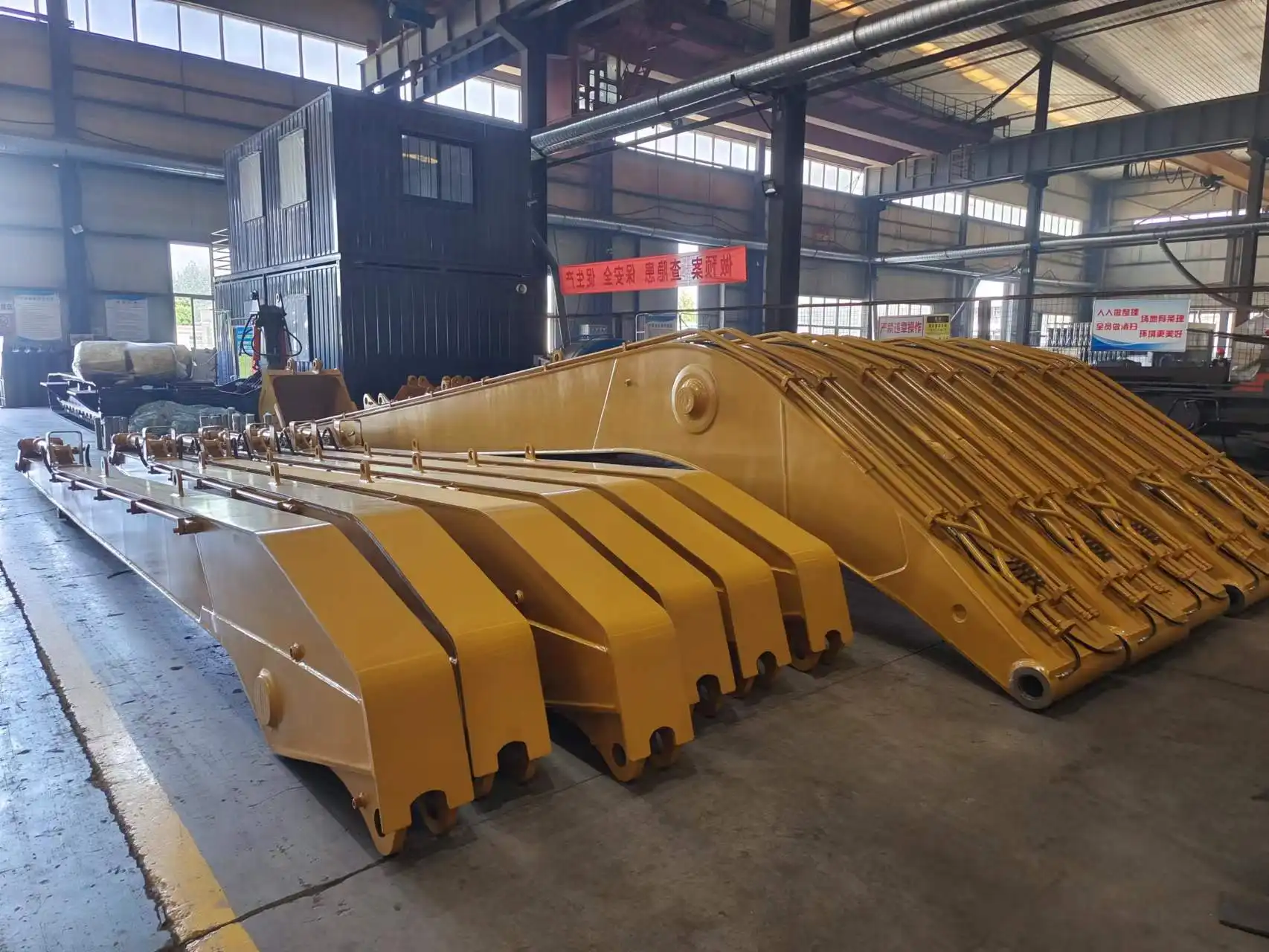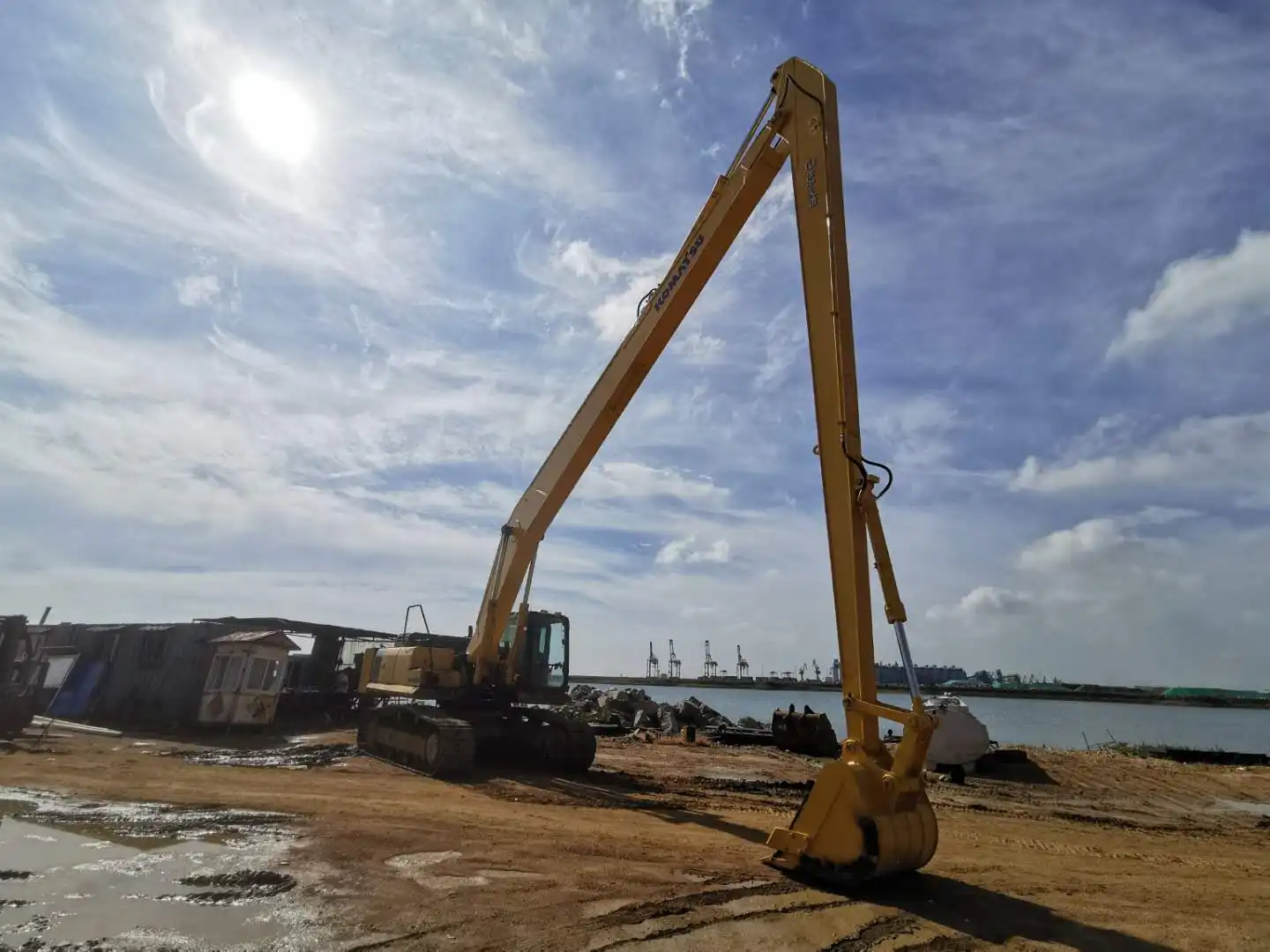Articulated boom VS Telescopic boom
When it comes to excavator booms, the choice between articulated and telescopic designs can significantly impact your project's efficiency and success. These two types of booms offer distinct advantages in various construction, mining, and earthmoving applications. Articulated booms provide exceptional flexibility and maneuverability, while telescopic booms excel in reaching greater heights and handling heavier loads. Understanding the key differences between these boom types is crucial for selecting the right equipment for your specific job requirements.

Key differences in design and functionality
Structural variations: Articulated vs. single-piece design
The fundamental distinction between articulated and excavator telescopic booms lies in their structural design. Articulated booms feature multiple sections connected by pivot points, allowing for a wide range of motion and flexibility. These joints enable the boom to bend and fold, making it ideal for navigating complex workspaces. On the other hand, telescopic booms consist of a single, extendable arm that slides out to increase reach. This simpler design offers stability and strength, particularly when extended to great heights.
Range of motion: Flexibility of articulated booms
Articulated booms shine when it comes to versatility in movement. The multiple pivot points allow for a greater range of motion, enabling operators to maneuver around obstacles and access hard-to-reach areas. This flexibility is particularly valuable in confined spaces or when working on uneven terrain. The ability to adjust the boom's configuration on the fly makes articulated booms an excellent choice for projects that require frequent repositioning or working at various angles.
Load capacity: Telescopic booms' strength advantage
While articulated booms offer superior flexibility, telescopic excavator booms generally have the upper hand in load-bearing capacity. The single-piece design of telescopic booms provides enhanced stability, especially when fully extended. This structural advantage allows telescopic booms to handle heavier loads at greater heights, making them ideal for tasks that require lifting substantial weights or reaching elevated work areas. The robust nature of telescopic booms also contributes to their popularity in construction and industrial applications where strength and reach are paramount.

Comparing reach and maneuverability in tight spaces
Articulated booms excel in confined work environments
In cramped job sites or areas with numerous obstacles, articulated booms truly come into their own. Their ability to bend and fold allows operators to navigate around structures, equipment, and other impediments with ease. This maneuverability is particularly valuable in urban construction projects, interior demolition work, or any application where space is at a premium. The articulated design enables precise positioning of attachments, enhancing productivity and reducing the risk of accidental damage to surrounding structures.
Telescopic booms offer superior vertical reach capabilities
When it comes to reaching great heights, telescopic excavator booms have a clear advantage. Their extendable design allows for impressive vertical reach, making them ideal for tasks such as high-rise construction, bridge maintenance, or accessing elevated work platforms. The single-piece structure of telescopic booms also contributes to their stability at height, providing operators with a secure working environment even when fully extended. This vertical reach capability makes telescopic booms the go-to choice for projects that require consistent work at significant elevations.
Impact of boom type on excavator stability and balance
The choice between articulated and telescopic excavator booms can significantly affect an excavator's overall stability and balance. Articulated booms, with their multiple pivot points, distribute weight more evenly across the machine, potentially offering better stability on uneven terrain. However, this flexibility can also introduce more variables in terms of balance, particularly when working at the extremes of the boom's range. Telescopic booms, with their simpler design, often provide more predictable balance characteristics, especially when extended. This stability can be crucial in applications where precise control and steady positioning are essential.

Choosing the right boom for your project
Assessing job site requirements for optimal boom selection
Selecting the appropriate excavator boom type hinges on a thorough evaluation of your project's specific needs. Consider factors such as the working environment, required reach, load capacities, and the variety of tasks to be performed. For projects involving frequent repositioning or work in tight spaces, an articulated boom may be the better choice. Conversely, if your project demands consistent work at height or handling heavier loads, a telescopic boom might be more suitable. It's also important to consider the terrain and any potential obstacles that may impact the excavator's operation.
Cost-effectiveness: Maintenance and operational expenses
When weighing the cost-effectiveness of articulated versus telescopic excavator booms, it's crucial to look beyond the initial purchase price. Articulated booms, with their more complex design, may require more frequent maintenance due to the additional moving parts and pivot points. However, their versatility can lead to increased productivity in certain applications, potentially offsetting higher maintenance costs. Telescopic booms, while generally simpler in design, may have higher operational costs when used frequently at full extension due to increased stress on the hydraulic systems. Consider the long-term operational and maintenance expenses alongside your project's specific requirements to make an informed decision.
Versatility: Adapting booms for various attachments
Both articulated and telescopic excavator booms can accommodate a wide range of attachments, enhancing their versatility on the job site. Articulated booms, with their flexible design, often excel in applications requiring frequent attachment changes or the use of specialized tools. Their ability to maneuver in tight spaces can be particularly advantageous when using attachments for precise work. Telescopic booms, while less flexible, can often handle heavier attachments and provide a stable platform for tasks requiring consistent positioning. When selecting a boom type, consider the range of attachments you'll need and how well each boom design complements their use.
Choosing between articulated and telescopic booms for your excavator ultimately depends on your project's specific requirements. Articulated booms offer unparalleled flexibility and maneuverability, making them ideal for complex work environments and tasks requiring precise positioning. Telescopic booms, with their superior reach and load-bearing capacity, excel in applications demanding consistent work at height or handling heavy loads. By carefully assessing your job site needs, considering long-term operational costs, and evaluating the versatility required for your projects, you can make an informed decision that enhances productivity and efficiency in your earthmoving operations.
FAQ
①Q: Which boom type is better for urban construction projects?
A: Articulated booms are often preferred for urban construction due to their superior maneuverability in tight spaces and around obstacles.
②Q: Can telescopic booms handle heavier loads than articulated booms?
A: Generally, yes. Telescopic booms typically have a higher load-bearing capacity, especially when fully extended, due to their single-piece design.
③Q: Are articulated booms more difficult to maintain than telescopic booms?
A: Articulated booms may require more frequent maintenance due to their multiple pivot points and complex design, but this can vary based on usage and conditions.
④Q: Which boom type provides better stability on uneven terrain?
A: Articulated booms often provide better weight distribution on uneven terrain, but telescopic booms can offer more predictable balance characteristics.
⑤Q: Can both boom types be used with a variety of attachments?
A: Yes, both articulated and telescopic booms can accommodate various attachments, but their suitability may depend on the specific attachment and task requirements.
Standard Size Excavator Boom And Arm Factory
At Tiannuo Machinery, we specialize in manufacturing high-quality excavator booms and arms tailored to your specific needs. Our product range includes standard and custom-designed booms and arms for various applications in railway maintenance, construction, mining, and more. We offer innovative solutions such as excavator lifting cabs, extended arms, and specialized attachments to enhance your equipment's versatility and performance. Our engineering team utilizes advanced computer-aided design systems to ensure optimal stress analysis, material selection, and production processes. For expert advice on selecting the right boom or arm for your project, contact us at raymiao@stnd-machinery.com.
References
- Construction Equipment Guide: Excavator Boom Types
- Journal of Construction Engineering and Management
- TianNuo Machinery Official Product Catalog
- Heavy Equipment Industry Report 2023
- Excavator Technology Trends: CONEXPO-CON/AGG 2023
- International Journal of Industrial Ergonomics
About Author: Arm
Arm is a leading expert in the field of specialized construction and railway maintenance equipment, working at Tiannuo Company. Tiannuo specializes in manufacturing a wide range of products, including railway maintenance equipment like railway sleeper changing machines and screening machines, excavator modification equipment such as excavator lifting cabs, various engineering arms for excavators, excavator accessories like digging buckets, and engineering vehicle auxiliary equipment like loader buckets.

